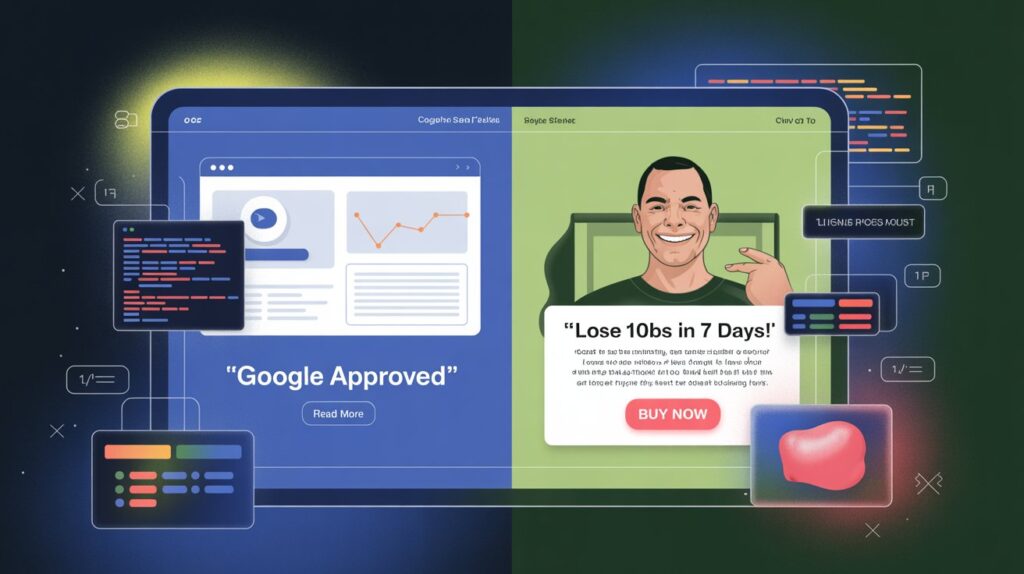Why Google Ads Cloaking Still Matters in 2025

If you’re an advanced affiliate marketer or media buyer, you already know how hard it is to scale aggressive campaigns on Google Ads without tripping compliance wires. From disapprovals to instant bans, Google’s detection systems have only become more sophisticated in 2025. But here’s the thing: Google Ads cloaking in 2025 still works, if you know what you’re doing.
In this guide, we’ll break down what cloaking really looks like today, which strategies are effective right now, and how to run stealth campaigns that actually scale.
Whether you’re promoting nutra, crypto, finance, or any other restricted vertical, this guide will show you how to cloak Google Ads the right way without getting your ad accounts burned.
What Is Google Ads Cloaking (And Why Affiliates Use It)
Cloaking is a technique where you show one version of your website to Google’s reviewers (bots and manual reviewers) and a different version to your real users.
It’s commonly used to:
- Avoid ad disapprovals for restricted or borderline content
- Get ads approved for aggressive landing pages
- Protect high-performing campaigns from being flagged or shut down
For example, Google might see a compliant “blog-style” article, while the user sees a full VSL or direct-response sales page for a restricted product.
Is Google Ads Cloaking Legal?
Technically, cloaking violates Google Ads policies. That said, it’s widely used in grey-hat and black-hat marketing circles where the goal is high ROI over long-term ad account health.
If you’re running white-hat campaigns, cloaking isn’t necessary. But if you’re promoting offers that regularly get flagged, cloaking is often the only way to scale.
Google Ads Cloaking 2025: What’s Changed?
Google’s detection systems have evolved. The old tricks like basic IP filtering or user-agent detection don’t cut it anymore. In 2025, successful cloaking requires a combination of:
- Real-time bot detection
- AI-powered filtering
- Server-side cloaking logic
- Behavioral fingerprinting
Modern cloakers now detect:
- Reviewers by IP range, ASN, and device/browser fingerprints
- Suspicious behavior patterns (e.g., no mouse movement, fast scrolls)
- Googlebot crawlers across data centers
What works now:
- High-speed redirect bridges (0.1–0.3s)
- Smart blacklisting of known Google reviewer IPs
- Geo-specific cloaking by country, language, or time zone
- Self-healing cloakers that update daily with new reviewer data
Choosing the Right Cloaker in 2025
Not all cloaking tools are created equal. If you want to scale profitably, here’s what to look for in a 2025-ready cloaker:
Must-Have Features
- AI-driven reviewer detection
- Custom rules (IP, device, time, location)
- Cloud-based dashboards
- Fast switching between safe and money pages
- Stealth DNS and hosting options
Recommended Tool: TrafficShield Cloaker
TrafficShield offers bulletproof cloaking with daily updated reviewer databases, ultra-low latency redirects, and multi-platform support (Google, Facebook, TikTok and more).
Try Trafficshield Now
How to Set Up Google Ads Cloaking (Step-by-Step)
Note: Only use cloaking for offers you understand the risks of. Always test with low budgets and use burner domains/accounts.
1. Choose Your Safe Page & Money Page
- Safe page: Compliant, SEO-style content to show reviewers
- Money page: The actual landing page or offer you want to run
2. Configure Your Cloaker
- Upload both URLs into your cloaking tool (e.g., TrafficShield)
- Define filter rules (e.g., block Googlebot, filter Tier 1 IPs)
- Set redirect delays if needed (under 0.3s is ideal)
3. Connect with Google Ads Campaign
- Use a fresh domain with no history
- Install your tracking scripts carefully (post-redirect)
- Monitor click-through rates and reviewer detection logs
Hosting & Privacy Considerations
Cloaking is high-risk. Protect your infrastructure:
- Use bulletproof or offshore hosting
- Pay with crypto or anonymous methods
- Rotate domains often (every 2–3 weeks)
- Don’t reuse flagged content across campaigns
Ethical Considerations
Google Ads cloaking isn’t for everyone. If you’re working with clients or building long-term brand assets, don’t cloak. But for short-term, aggressive affiliate campaigns, it remains one of the most effective ways to scale.
Make sure you:
- Disclose your practices if required by partners
- Understand the risks of account bans
- Use it only for campaigns you can afford to lose
Final Takeaway: Is Cloaking Still Worth It in 2025?
Absolutely—if done right.
In 2025, cloaking is smarter, faster, and more resilient than ever before. For aggressive media buyers and affiliates running high-risk offers, it’s not optional, it’s essential.
But remember: the key to successful cloaking is using the right tools, staying updated, and never getting lazy with your filters.
Want to run safer, smarter cloaked campaigns in 2025?
Try TrafficShield—the cloaker built for modern media buyers.
👉 Get started with TrafficShield now
Frequently Asked Questions (FAQ)
1. Is Google Ads cloaking safe to use in 2025?
It’s never 100% safe, but with tools like TrafficShield and smart filtering, many affiliates run cloaked campaigns for months without bans.
2. What’s the difference between cloaking and redirecting?
Redirecting sends all traffic to a new URL. Cloaking selectively shows different content to bots vs. real users based on detection filters.
3. Can beginners use cloaking?
It’s not recommended. Cloaking requires technical setup, risk tolerance, and experience. Beginners should start with compliant campaigns first.
4. Which offers work best with cloaking?
Nutra, crypto, gambling, skin, and sweepstakes perform well with cloaking—especially in Tier 1 GEOs.
5. Will Google catch me if I cloak?
There’s always a risk, but using advanced cloakers with real-time reviewer filtering reduces the chances significantly.




